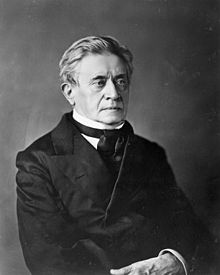Joseph Henry
Joseph Henry (born December 17, 1797 in Albany , New York , † May 13, 1878 in Washington, DC ) was a leading American physicist .
Life
Henry was born in Albany (New York) and first trained as a watchmaker and silversmith. His grandfather immigrated from Scotland.
Henry became professor of mathematics and natural philosophy at the Albany Academy in 1826 and began the first experiments with electricity in 1827 . Even before Samuel Morse's experiments , Henry provided evidence that messages can be exchanged between two distant locations using the electric telegraph (1831 in the American Journal of Science ).
In 1832 Henry became a professor of natural sciences at Princeton College and remained there until 1837. In 1835 he was elected to the American Philosophical Society and in 1840 to the American Academy of Arts and Sciences . In 1846 he became the first secretary of the Smithsonian Institution in the federal capital Washington and can be regarded as the spiritual father of this institution.
In 1849 he was president of the American Association for the Advancement of Science .
In 1850 Henry was elected a member of the Leopoldina , in 1852 he became a member of the Lighthouse Commission, of which he was president between 1871 and 1878. From 1868 to 1878 he was President of the National Academy of Sciences , of which he was a founding member in 1863.
plant
Henry's main field of work was electromagnetism , where he discovered the phenomenon of self-induction . At the same time Michael Faraday formulated the principle of mutual induction in England , which is technically used in transformers . After Hans Christian Ørsted discovered the magnetic effects of a current-carrying conductor , Henry was the first to come up with the idea of creating an electromagnet using multiple conductor loops or a coil around an iron core . An electromagnet he built for Yale could lift a load of 2,300 pounds (about 1,040 kg). He also invented the electromagnetic relay in 1835 , without which neither the simple switching of electrical circuits nor telegraphy over long distances would have been possible.
effect
His main interest was now the weather. He recruited volunteer weather observers and organized a telegraphic network to transmit the weather data. Henry drew the first weather map in the history of meteorology and laid the scientific basis for the system of daily weather forecasting.
Commissioned by the American government, he constructed lighthouses and fog horns with greater range and invented improved navigational instruments to make coastal navigation safer. In his honor, which is the SI unit of electrical inductance with Henry ( unit symbol designated H). A memorial was erected in his honor in front of the Smithsonian Institution . In addition, the Henry Moon Crater and the Henry Mountains in southeast Utah are named after him.
Stations of his life
- 1826 - Teacher of math and science at Albany Academy , New York.
- 1832 - Professor of Physics at Princeton.
- 1835 - Invention of the electromechanical relay .
- 1846 - First Secretary of the Smithsonian Institution until his death in 1878
- 1848 - Ephraim G. Squier and Edwin H. Davis edited the institute's first publication, Ancient Monuments of the Mississippi Valley
- 1852 - Appointed to the Lighthouse Board
- 1871 - Appointed Chairman of the Lighthouse Board
Fonts
- Contributions to electricity and magnetism . Philadelphia (1839)
- Joseph Henry: A summary of researches in sound: conducted in the service of the United States Light-House Board, during the years 1865-1877 Publishers: Government Printing Office, Washington, 1879
- Arnold Guyot and Joseph Henry: Directions for meteorological observations, and the registry of periodical phenomena . Publisher: Smithsonian institution Washington, 1860
- A memorial of Joseph Henry . Published by order of Congress (45th, 3rd session: 1878-1879). Publisher: Government Printing Office, Washington 1880
- "List of the scientific papers of Joseph Henry": p. 365-374
- Memoir of Joseph Henry by Simon Newcombe. Read before the National Academy of Science April 21, 1880
Web links
- Joseph Henry in the nndb (English)
- Literature by and about Joseph Henry in the WorldCat bibliographic database
- History of Henry
- Joseph Henry in Smithsonian Institution
- Joseph Henry: Inventor of the Telegraph? By David Hochfelder
- Joseph Henry 1868-1878 NAS President
- Paintings and photographs by Joseph Henry in the archives of the Smithsonian Institute
- Planning a National Museum
Individual evidence
- ^ Member History: Joseph Henry. American Philosophical Society, accessed September 28, 2018 .
| personal data | |
|---|---|
| SURNAME | Henry, Joseph |
| BRIEF DESCRIPTION | American scientist and professor at Princeton University |
| DATE OF BIRTH | December 17, 1797 |
| PLACE OF BIRTH | Albany , New York |
| DATE OF DEATH | May 13, 1878 |
| Place of death | Washington, DC |

